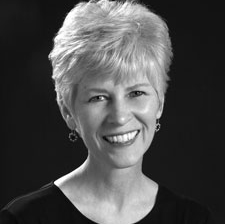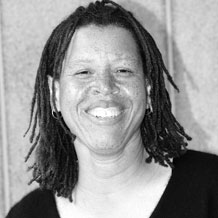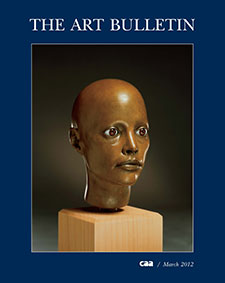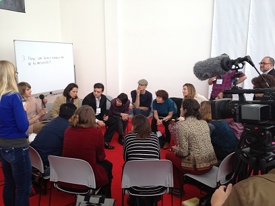CAA News Today
New Officers for the Board of Directors
posted by Christopher Howard — March 27, 2012
At its February 2012 meeting, the CAA Board of Directors chose new officers—four vice presidents and a secretary—from among its members to serve one-year terms, from May 2012 to April 2013. Elected officers (other than the president) hold their positions for one year and may be reelected to a second term. For more information about the election process for officers, please read Article VII, Section 5 of the CAA By-laws.
 Patricia McDonnell, Vice President for External Affairs
Patricia McDonnell, Vice President for External Affairs
The board reelected Patricia McDonnell, director of the Ulrich Museum of Art at Wichita State University in Kansas, for a second term as vice president for external affairs. A member of the board since 2009, McDonnell will work closely with Linda Downs, CAA executive director, and Nia Page, CAA director of membership, development, and marketing, on fund-raising initiatives and advocacy matters.
 DeWitt Godfrey, Vice President for Committees
DeWitt Godfrey, Vice President for Committees
DeWitt Godfrey, an artist and associate professor of art and art history at Colgate University in Hamilton, New York, was elected vice president for committees. He will act as a liaison between the board and the nine Professional Interests, Practices, and Standards Committees and coordinate committee work that advances CAA’s goals. A board member since 2009, Godfrey succeeds Maria Ann Conelli, dean of the School of Visual, Media, and Performing Arts at Brooklyn College, City University of New York, who served two terms as vice president for committees. (Conelli has been named secretary; see below.)
 Jacqueline Francis, Vice President for Annual Conference
Jacqueline Francis, Vice President for Annual Conference
Jacqueline Francis, professor of art history at California College of the Arts in San Francisco, has been named vice president for Annual Conference. She will chair the Annual Conference Committee, which determines conference programming and content, and work with CAA staff to devise and implement flexible session scheduling and formats for the event. A board member since 2009, Francis succeeds Anne Collins Goodyear, assistant curator of prints and drawings at the National Portrait Gallery, Smithsonian Institution, who served CAA in this position for one year. (Goodyear will become board president in May 2012; see below.)
 Randall C. Griffin, Vice President for Publications
Randall C. Griffin, Vice President for Publications
The board reelected Randall C. Griffin, professor of art history at Southern Methodist University in Dallas, Texas, to a second term as vice president for publications. A member of the board since 2008, Griffin will oversee CAA’s publications program, serve as chair of the Publications Committee, and be a resource for the editorial boards of the three scholarly journals, The Art Bulletin, Art Journal, and caa.reviews.
 Maria Ann Conelli, Secretary
Maria Ann Conelli, Secretary
Maria Ann Conelli, dean of the School of Visual, Media, and Performing Arts at Brooklyn College, City University of New York, has been elected secretary. This officer attends and records minutes for all board and Executive Committee meetings. In addition, the secretary notifies CAA members about the Annual Members’ Business Meeting, held every year at the Annual Conference, and attends and records minutes of this meeting. A board member since 2009, Conelli succeeds DeWitt Godfrey, an artist and associate professor of art and art history at Colgate University, who has become vice president for committees (see above).
 Anne Collins Goodyear, President
Anne Collins Goodyear, President
In October 2011, the board chose Anne Collins Goodyear, assistant curator of prints and drawings at the National Portrait Gallery, Smithsonian Institution, in Washington DC, to serve as the organization’s next president for a two-year term, beginning May 2012. A member of the board since 2006, Goodyear has served as vice president for external affairs (2007–9), vice president for publications (2009–11), and vice president for Annual Conference (2011–12). She succeeds Barbara Nesin, who has led the board since May 2010.
March 2012 Picks from CAA’s Committee on Women in the Arts
posted by Christopher Howard — March 23, 2012
 Each month, CAA’s Committee on Women in the Arts produces a curated list, called CWA Picks, of recommended exhibitions and events related to feminist art and scholarship in North Americn and around the world.
Each month, CAA’s Committee on Women in the Arts produces a curated list, called CWA Picks, of recommended exhibitions and events related to feminist art and scholarship in North Americn and around the world.
The CWA Picks for March 2012 go international with solo exhibitions of work by Rosemarie Trockel in Belgium, Eija-Liisa Ahtila in Sweden, and Kimsooja in France. In the United States, the Museum of Modern Art in New York is hosting a career survey of photographs by Cindy Sherman, arguably one of the most influential artists of the past fifty years. Close at her heels are the Guerrilla Girls, who have taken over two galleries at Columbia College Chicago for their own retrospective, which comprises their important works of art and activism since the 1980s. Rounding out the March picks are a special collaboration between the British artist Rachel Kneebone and the French sculptor Auguste Rodin at the Brooklyn Museum and the graphic production of Sister Mary Corita at the National Museum of Women in the Arts in Washington, DC.
Check the archive of CWA Picks at the bottom of the page, as several museum and gallery shows listed in previous months may still be on view or touring.
Image: Cindy Sherman, Untitled #463, 2007–8, chromogenic color print, 68⅝ x 72 in. (artwork © Cindy Sherman; photograph provided by the artist, Metro Pictures, and the Museum of Modern Art)
Take the 2012 Annual Conference Survey
posted by Christopher Howard — March 19, 2012
Earlier this month, CAA sent an email blast to 2012 Annual Conference attendees, asking for feedback on all aspects of last February’s event. Please complete the survey, which has several fields for open-ended answers, by Friday, March 23, 2012.
The survey asks you to identify yourself (artist, art historian, student, etc.) and your type of institutional affiliation and then to rate your experiences with various conference events and services—from online registration and the conference hotels to session content and Career Services activities. If you attended the Book and Trade Fair or used your conference badge for free museum admission, let CAA know. The survey also asks your thoughts about the conference website and how CAA can better deliver conference information.
March 2012 Issue of The Art Bulletin Introduces Three New Article Series
posted by Christopher Howard — March 13, 2012
 Three new series of features are introduced in the March 2012 issue of The Art Bulletin. They will appear in the next two volume years of the journal, along with the long-form essays and reviews that have made it the leading publication of international art-historical scholarship. In her introductory editor’s note, Karen Lang writes that she created the new features “to reflect the vibrancy of art history today and to stimulate dialogue across fields and with neighboring disciplines.”
Three new series of features are introduced in the March 2012 issue of The Art Bulletin. They will appear in the next two volume years of the journal, along with the long-form essays and reviews that have made it the leading publication of international art-historical scholarship. In her introductory editor’s note, Karen Lang writes that she created the new features “to reflect the vibrancy of art history today and to stimulate dialogue across fields and with neighboring disciplines.”
In the first new series, “Regarding Art and Art History,” a leading scholar offers a short personal reflection on what it means to write art history; the inaugural writer is Anne M. Wagner, whose essay takes the form of a letter. “Notes from the Field” will present short texts on a given topic by ten authors from a variety of disciplines; the first topic is anthropomorphism, with texts by the artist Elizabeth King, the philosopher J. M. Bernstein, and eight other scholars, including Finbarr Barry Flood, Jane Garnett, and James Meyer. Each issue will feature an interview as well; the first is a dialogue between the curator Hans Ulrich Obrist and the art historian Philip Ursprung. Julia Gelshorn launches the feature with a critical essay on the techniques, strategies, and study of the artist interview.
The March issue also features three essays on diverse topics. In “Henry Fuseli: Greek Tragedy and Cultural Pluralism,” Andrei Pop examines the art of the Anglo-Swiss painter Henry Fuseli in relation to the eighteenth-century revival of Greek tragedy and the formation of the modern liberal version of cultural pluralism. Yukio Lippit’s article, “Of Modes and Manners in Japanese Ink Painting: Sesshū’s Splashed Ink Landscape of 1495,” explores a single work by the Zen monk painter Sesshū Tōyō in the context of the ink painting tradition and artistic transmission in medieval Japan. In her essay, “Agent Provocateur? The African Origin and American Life of a Statue from Côte d’Ivoire,” Monica Blackmun Visonà studies the “biography” of a statue, sculpted near the Lagoon region of Ivory Coast and later donated to Fisk University by Georgia O’Keeffe, as a microcosm of American art history in the twentieth century.
In the Reviews section, Sheila Dillon evaluates Richard Neer’s book, The Emergence of the Classical Style in Greek Sculpture, and Julian Gardner considers The Likeness of the King: A Prehistory of Portraiture in Late Medieval France by Stephen Perkinson. Next, Gerhard Wolf looks at the temporality of Renaissance art as described in Alexander Nagel and Christopher S. Wood’s Anachronistic Renaissance. Finally, Marc Fumaroli reviews Walter S. Melion’s book, The Meditative Art: Studies in the Northern Devotional Print (1550–1625).
Please see the full table of contents for March to learn more. CAA sends The Art Bulletin to all institutional members and to those individuals who choose to receive the journal as a benefit of their membership.
The next issue of The Art Bulletin, to be published in June 2012, will feature a “Notes from the Field” section on appropriation and an interview with the art historian Linda Nochlin. The long-form essays will examine artifacts from a tenth-century cave in northwestern China, portraiture and narrative in the 1605 Shahnama (Book of Kings), theater architecture in the 1914 Werkbund exhibition, and Pablo Picasso’s 1912 paper construction Guitar. The Reviews section will include analyses of books on Caravaggio, Jean-Léon Gérôme, Spanish portraiture, the art of early modern China, and the temporality of architecture.
Recent Deaths in the Arts
posted by Christopher Howard — March 12, 2012
In its regular roundup of obituaries, CAA recognizes the lives and achievements of the following artists, designers, architects, photographers, dealers, filmmakers, and other men and women whose work has had a significant impact on the visual arts. This month was marked by the loss of three major artists: Mike Kelley, Dorothea Tanning, and Antoni Tàpies.
- Leopold (Lee) Adler II, former president of the Historic Savannah Foundation, died on January 29, 2012. He was 88 years old. Born into a wealthy Savannah family, Adler worked all his life to preserve the city’s eighteenth- and nineteenth-century homes, gaining a reputation as a committed preservationist
- Theo Angelopoulos, a celebrated Greek filmmaker whose work placed him in a critical pantheon of auteur directors, among them Michelangelo Antonioni, died on January 24, 2012. He was 76. Angelopoulos’s best-known films include Eternity and a Day (1998), which won the Palme d’Or at the Cannes Film Festival. At the time of his death, Angelopoulos was working on The Other Sea, the last film in a trilogy about Greek history
- Carolyn Autry, an artist, printmaker, and educator who taught at the University of Toledo in Ohio for thirty-six years, died on December 12, 2011, at the age of 71. Autry exhibited her work nationally and internationally and was an avid world traveler in her final years
- Lillian Bassman, a fashion and fine-art photographer, died on February 13, 2012, age 94. Bassman first came to prominence in the 1940s as an art director for Junior Bazaar, a youth-orientated version of Harper’s Bazaar. She also showed her pictures in galleries around the world, influencing several generations of fashion photographers
- Emmanuel Cooper, a ceramicist, died on January 21, 2012, at the age of 73. Cooper was primarily known as potter but also established himself as an art critic, educator, and gay-rights activist. His work is in the permanent collection of the Victoria and Albert Museum in London and the Philadelphia Museum of Art
- Mary Louise Coulouris, a vibrant painter, printmaker, and muralist, died on December 20, 2011, at the age of 72. Born in New York to Greek parents, Coulouris moved to London to attend school, eventually settling in Scotland. Well known for her public artworks in railway stations and hospitals across the United Kingdom, she also showed in galleries in Paris and London and is included in the collections of the New York Public Library, the Bibliothèque National in Paris, and the Ashmolean Museum in Oxford, England
- Peter de Francia, a celebrated artist, intellectual, and professor of painting at the Royal College of Art in London, passed away on January 19, 2012, at the age of 90. De Francia, born in France to an English mother and an Italian father, was multilingual from an early age. He served in World War II and was a lifelong socialist and an active member of the British art scene since the 1950s
- Malcolm Fowler, a fine artist and illustrator who brought artful creativity and humor into the world of advertising, died on January 18, 2012, at age 68. Fowler founded the pioneering illustration and model-making Shirt Sleeve Studio in London with his wife, Nancy Fouts, in the late 1960s. The couple crafted seminal ad campaigns for Tate Gallery, and their work has been collected by the Victoria and Albert Museum
- John Gage, a beloved, freethinking art historian known for his scholarship on J. M. W. Turner, died on February 13, 2012, age 73. Gage taught art history at the University of Cambridge from 1970 to 1996 and was elected a fellow of the British Academy in 1995
- Robert E. Hecht Jr., a controversial American dealer in ancient antiquities died, on February 8, 2012, at the age of 92. Just three weeks prior to his death, Hecht was on trial in Rome for charges of antiquity tomb looting and black-market dealing. A lifelong passion for collecting and selling ancient art began when he was a student at the American Academy in Rome
- John House, an art historian known for his scholarship on Impressionism, specifically Claude Monet, passed away on February 7, 2012. He was 66. House began teaching at the University of East Anglia and University College of London before going to the Courtauld Institute of Art. He often took a radical approach to his subject, challenging previous scholarship with his books and with the popular exhibitions he organized
- Mike Kelley, a groundbreaking artist who put Los Angeles on the map as a contemporary art mecca, committed suicide at the age of 57 on February 1, 2012. Kelley worked in video, installation, painting, and performance, often combining genres to spectacular and grotesque effect. A traveling retrospective of Kelly’s work, originating at the Stedelijk Museum in Amsterdam, will come to the Museum of Contemporary Art in Los Angeles in 2014
- Ricardo Legorreta, the Mexican-born architect known for his design of vibrant, modernist buildings throughout the southwestern United States and internationally, died on December 30, 2011. He was 80
- Steven Leiber, a San Franciscan art collector and rare-book dealer, died on January 28, 2012. He was 54 years old. Leiber operated a website devoted to his collection and knowledge of art ephemera and helped appraise several important archives, including those of Avalanche magazine, Allan Kaprow, and Claus Oldenberg
- John Madin, an architect and planner who transformed the look of postwar England, passed away on January 8, 2012. He was 87. Madin is known for his monolithic designs for commercial buildings in cities throughout the North of England, the West Midlands, and Leeds
- Isi Metzstein, an esteemed Scotish architect and teacher, died on January 10, 2012, at age 83. Metzstein founded the architectural practice Gillespie Kidd and Coia, which designed churches in Scotland, including the Le Corbusier–influenced St. Peter’s Seminary (now falling into ruin), and created buildings for Robinson College and Cambridge University
- Amy Page, a writer and former editor-in-chief of Art + Auction magazine passed away on January 19, 2012, at age 72. A native New Yorker, Page was as comfortable in the rough and tumble world of art journalism as she was with socializing with collectors, gallery directors, and traveling the world to attend art fairs
- Gianfranco Pardi, an Italian artist who created minimalist paintings, died on February 2, 2012, at age 78. Pardi lived and worked in Milan, where he showed at the Gio Marconi Gallery. In 1986 he exhibited at the Venice Biennale, and his 1970s series Architettura combines hard-edge abstraction, drawing, cable wires and aluminum
- Vita Petersen, an artist, teacher, and legendary fixture at the New York Studio School, passed away on October 22, 2011, age 96. Born in Berlin to an aristocratic, art-loving family, Petersen moved to New York in 1938 and became involved in the heady art scene of the 1940s and 1950s. She showed her colorful abstractions at the Betty Parsons Gallery in the 1960s and was known to paint every day of her life
- Jessie Poesch, an art professor at Tulane University’s Newcomb College in New Orleans, died on April 23, 2011, at the age of 88. Poesch was a specialist in decorative arts, pottery, and Louisiana architecture. She taught at Newcomb College from 1963 to 1992 and wrote books and articles that established her as an expert in her field
- Julie Carter Preston, a Liverpool-born ceramicist whose clients included members of the British Royal Family, died on January 6, 2012. She was 85 years old. Preston is best known for her use of sgraffitto, an ancient scratching technique that creates a rich-looking surface texture. She taught for many years at the Liverpool College of Art, and her work is represented by the Walker Art Gallery in Liverpool
- Peter Saunders, a British painter whose favorite subject was the city of London and its people, passed away on November 19, 2011, age 70. Saunders attended Camberwell School of Art, where he studied under Euan Uglow. He later taught at schools throughout London and was a member of the Soho crowd of artists who gathered at the Colony Room in the 1960s and 1970s
- Ian Simpson, an artist and art instructor who was a presenter on the BBC program Eyeline (1968–69), died on December 15, 2011, at the age of 78. Simpson taught at Hornsey College of Art in London and at St Martins School of Art from 1972 to 1988. He was a great believer in demystifying the world of art-making, and that technical skills could be taught to anyone with the dedication to learn them
- Norma Merrick Sklarek, the first African American woman to become a licensed architect, died on February 6, 2012, aged 85. Born in Harlem, Sklarek was one of only two women to graduate from Columbia University with a degree in architecture. She moved to Los Angeles to join Gruen Associates in 1960, where she worked as the project director for Terminal 1 at Los Angeles International Airport and later was a founding partner of Siegel-Sklarek-Diamon, an all-woman architectural firm
- Kazimierz Smolen, the former director and cofounder of the State Museum at Auschwitz-Birkenau and a survivor of the concentration camps at Auschwitz and Mauthausen, died on January 27, 2012, at the age of 91. In addition to founding the State Museum at Auschwitz, he appeared as a witness in many war criminal trials, including the Nuremberg Trials in 1945–46
- Tobi Lim Sonstroem, a graphic-design alumnus of the Tyler School of Art in Pennsylvania, took his own life on February 2, 2012. He was 25 years old. Sonstroem was remembered by friends and teachers as a passionate young man who was dedicated to his burgeoning art and graphic-design career
- Dorothea Tanning, a painter, sculptor, and muse to the Surrealists, died on January 31, 2012. She was 101 years old. Tanning was married for thirty years to Max Ernst and lived with him in New York, Arizona, and France. In addition to an esteemed career as a painter, she published several books of verse and in 1994 established the $100,000 Wallace Stevens Award at the Academy of American Poets
- Antoni Tàpies, the Catalan painter known for large-scale works that often mix oil painting with sand, chalk, and household objects, died on February 6, 2012. He was 88. The critic Roland Penrose described Tàpies as “a painter who was to create mysteries in matter itself.” The Tàpies Foundation in Barcelona, Spain, was created in 1984 as a museum and research center dedicated to the artist’s work and to other international modern artists
- Eugene Weston III, an architect who revolutionized the look of Los Angeles homes in the 1950s, died on January 31, 2012, at the age of 87. Weston’s designs emphasized space, glass windows, and natural light, bringing an elegant, modern sensibility to middle-class family homes. Later commissions include the Scripps College Research Center and the San Diego Zoo
- Erica Wilson, a craftswoman who popularize embroidery and needlework through numerous television appearances, books, and magazine articles, died on December 13, 2011. She was 83. The British-born Wilson moved to New York in 1954, where she taught at Cooper Union and gave private lessons in her apartment. Wilson later opened boutique shops on Manhattan’s Upper East Side and on Long Island, as well as in Palm Beach, Florida, and in Nantucket, Massachusetts
- Althea Wynne, a British sculptor known for her equestrian statues in bronze and ceramic, died on January 24, 2012, at the age of 75. Inspired by Etruscan art and a childhood love of horseback riding, Wynne created sculptures recognized as powerful and graceful monuments. Her best-known commission is the three bronze horses that stand sentinel at Minister Court in the City of London
Read all past obituaries in the arts in CAA News, which include special texts written for CAA. Please send links to published obituaries to Christopher Howard, CAA managing editor, for the April listing.
Winter Art Journal Explores and Exploits Print
posted by Christopher Howard — March 02, 2012
 The latest issue of Art Journal, mailed in February, is dedicated to manifestations of print, from the cultural roles of published artifacts in the nineteenth and twenty-first centuries (by Michael Leja and the editors of the collective Triple Canopy respectively) to artist’s projects by Richard Tuttle and Matthew Brannon that exploit the physical conditions of the printed journal itself.
The latest issue of Art Journal, mailed in February, is dedicated to manifestations of print, from the cultural roles of published artifacts in the nineteenth and twenty-first centuries (by Michael Leja and the editors of the collective Triple Canopy respectively) to artist’s projects by Richard Tuttle and Matthew Brannon that exploit the physical conditions of the printed journal itself.
The final Art Journal Centennial essay by Sarah Suzuki surveys up-to-the-moment practices in printmaking, while a piece by Harper Montgomery focuses on a Mexico City street exhibition of prints in 1929 as an instance of the political dimensions of distributing art prints. Finally, an essay by Bruce Hainley, “Store as Cunt,” explores the subversive 1960s work of the artist Sturtevant.
The Triple Canopy essay, “The Binder and the Server,” which received the 2012 Art Journal Award at the CAA Annual Conference last month, and Seth McCormick’s review of Hiroko Ikegami’s book The Great Migrator: Robert Rauschenberg and the Global Rise of American Art are featured as free content on the journal’s website.
Take NAMTA’s Triennial Artists & Art Materials Survey
posted by Christopher Howard — February 28, 2012
 The International Art Materials Association (NAMTA), an organization of more than 550 professional art-materials businesses, conducts a study of artists and art materials every three years and is asking all artists, art students, and art instructors to contribute by completing an online survey by Monday, April 2, 2012. The survey is open to American and Canadian artists, over the age of 18, working in any medium. CAA especially encourages art students at both the graduate and undergraduate levels to participate.
The International Art Materials Association (NAMTA), an organization of more than 550 professional art-materials businesses, conducts a study of artists and art materials every three years and is asking all artists, art students, and art instructors to contribute by completing an online survey by Monday, April 2, 2012. The survey is open to American and Canadian artists, over the age of 18, working in any medium. CAA especially encourages art students at both the graduate and undergraduate levels to participate.
Prizes
For individuals: Two lucky survey participants are eligible to win $200 each in gift certificates to an art-supply store.
For schools: A gift box of art supplies will be awarded to the top five colleges that have the most students complete the survey. The gift box includes: Strathmore drawing pads, Golden and Liquitex acrylic paint sets, Winsor and Newton oil paint sets and brushes, a $100 gift certificate to Art Supply Warehouse, the Artist’s Magazine, and a book, Rethinking Acrylic.
Participants must register to receive the executive summary and to enter the drawing by clicking on the link on the thank-you page after submitting their completed survey. The drawing and executive summary sign-up is separate from the survey to keep the survey anonymous. All survey responses are anonymous and will only be reported as part of summary figures like totals or averages. Visit the website of Hart Business Research, which is administering the survey, to learn more about how to enter the drawing and competition.
NAMTA is donating $1 for each completed survey (for the first five hundred completed) to scholarships through the NAMTA Foundation for the Visual Arts.
About the Survey
The survey is the first phase of a larger study, titled Artists & Art Materials 2012, which will also include a questionnaire for retailers of art supplies. In the study’s second phase, Hart Business Research will analyze this survey data as well as data from the National Endowment for the Arts, various artist nonprofits, the United States Census, and individual artists’ websites to build a comprehensive picture of artists’ evolving activities. The report will be announced in summer 2012, accompanied by an executive summary that will be made available to all survey participants.
Thanks to Conference Attendees and Participants
posted by Christopher Howard — February 27, 2012
 CAA warmly thanks the five thousand attendees, participants, exhibitors, and guests who made the 100th Annual Conference in Los Angeles a tremendous success.
CAA warmly thanks the five thousand attendees, participants, exhibitors, and guests who made the 100th Annual Conference in Los Angeles a tremendous success.
In the next few issues of CAA News, you will read more about the conference—including summaries of ARTspace, the Distinguished Scholar session honoring Rosalind Krauss, the speakout sessions, and more—as well as reports from the meetings of the Board of Directors and the Professional Interests, Practices, and Standards Committees, which all have full, exciting agendas for the coming year.
The 101st CAA Annual Conference will take place in New York, February 13–16, 2012. The 2013 Call for Participation, which solicits your papers and presentations for the event, will be published and mailed in March and also be available on the CAA website as a PDF for download.
Image: Graduate Public Practice from the Otis College of Art and Design presented “Re/Locating Learning: Public Practices as Art” at the Los Angeles conference (photograph by Christopher Howard)
Results of the 2012–16 Board of Directors Election
posted by Christopher Howard — February 24, 2012
The CAA Board of Directors welcomes four newly elected members, who will serve from 2012 to 2016:
- Suzanne Preston Blier, Harvard University
- Stephanie D’Alessandro, Art Institute of Chicago
- Gail Feigenbaum, Getty Research Institute
- Charles A. Wright, Western Illinois University
Barbara Nesin, CAA board president, announced the election results during the Annual Members’ Business Meeting, held on Friday, February 24, at the 100th Annual Conference in Los Angeles.
The Board of Directors is charged with CAA’s long-term financial stability and strategic direction; it is also the association’s governing body. The board sets policy regarding all aspects of CAA’s activities, including publishing, the Annual Conference, awards and fellowships, advocacy, and committee procedures.
For the annual board election, CAA members vote for no more than four candidates; they also cast votes for write-in candidates (who must be CAA members). The four candidates receiving the most votes are elected to the board.
Contribute to a Journal Issue on Digital Art History
posted by Christopher Howard — February 21, 2012
In 2013, Visual Resources: An International Journal of Documentation intends to publish a special issue dedicated to the topic of “Digital Art History.” For full details on the issue, please visit the Taylor and Francis webpage for the journal.
At present, the field of art history has amassed considerable knowledge concerning how to digitize texts and images and make them widely available in well-structured formats. However, the state of the field with respect to scholarship in the digital age is less clear. Visual Resources seek to answer the following questions and more:
- What kind of art-historical scholarship is now possible in the digital environment that could not be done before?
- What new types of questions can be posed now?
- How might digitized resources (texts and images) be used to produce innovative scholarship?
- How might the digital environment allow scholars to address existing or “traditional” questions with new evidence or conclusions?
While exploring what is now possible, it is also important to consider the challenges that the field of art history still faces with respect to scholarship in the digital age. Contributors might also ask what prevents the field of art history from widespread adoption of the new research tools and techniques associated with the digital humanities.
Visual Resources invites researchers and educators in art history and visual studies to submit proposals for this special issue. Abstracts should be 750 words in length and be accompanied by a one-page CV that includes up-to-date contact information for the proposed contributor(s). Abstracts and CVs should be sent to Murtha Baca and Anne Helmreich, coeditors for this special issue. Deadline: March 23, 2012 (5:00 PM PST).
Meet Baca, Helmreich, and representatives from Taylor and Francis at the upcoming CAA Annual Conference in Los Angeles on Friday afternoon, February 24, 2012, 2:30 PM, at the Routledge booth in the Book and Trade Fair. Refreshments will be served at the booth.


